Vimar 01727.1 Handleiding
Vimar
Niet gecategoriseerd
01727.1
Bekijk gratis de handleiding van Vimar 01727.1 (4 pagina’s), behorend tot de categorie Niet gecategoriseerd. Deze gids werd als nuttig beoordeeld door 52 mensen en kreeg gemiddeld 4.9 sterren uit 26.5 reviews. Heb je een vraag over Vimar 01727.1 of wil je andere gebruikers van dit product iets vragen? Stel een vraag
Pagina 1/4

Viale Vicenza, 14
36063 Marostica VI - Italy
www.vimar.com
49401438A0 02 1907
By-alarm
01727.1
By-alarm contatto RF magnetico+sensore shock.
Il rivelatore By-alarm con contatto magnetico è un dispositivo radio bidirezionale provvisto di un
sensore ad effetto HALL attivabile mediante magnete esterno e dispone di un particolare rilevatore
triassiale configurabile come sensore di shock o sensore di vibrazione. Il sensore di shock effettua
una misurazione dell'accelerazione su 3 assi con un livello di intensità programabile su 4 disponibili;
in questa modalità il sensore genera un allarme quando viene rilevata una singola perturbazione
dello stato di quiete che supera la soglia programmata. Il sensore di vibrazione effettua una misura-
zione dell'accelerazione su 3 assi con un livello di intensità programabile su 4 disponibili; in questa
modalità il sensore rileva le perturbazioni dello stato di quiete per un periodo fisso di 10 s entro i quali
attiva il conteggio degli eventi che superano la soglia di allarme e raggiunto il numero impostato si
attiverà la segnalazione di allarme. E' inoltre presente 1 ingresso per il collegamento di sensori filari
esterni. Il rivelatore non necessita di alcun collegamento via filo ed è alimentato da una batteria al
litio da 3 V modello CR123.
CARATTERISTICHE
• Alimentazione: batteria al litio 3 V CR123 fornita in dotazione
• Range di frequenza: 868 MHz
• Potenza RF trasmessa: < 25 mW (14dBm)
• Classe ricevitore: Classe 2 duty cycle <1%
• Durata media della batteria: 4 anni
• Avviso di batteria scarica: su interfaccia radio 01729 e in centrale
• Led:
- led giallo per navigazione menù
- led verde per ricezione dati
- led rosso per trasmissione dati
• Possibilità di utilizzo:
- sensore ad effetto HALL a bordo
- sensore triassiale per rilevazione shock e vibrazione.
- 1 contatto esterno NC, NO, a singolo bilanciamento con resistenza da 3,3k oppure per Ω
tapparella o inerziale
• Temperatura di funzionamento: -10..+60 °C
• Dimensioni: 95x29x24 mm
COLLEGAMENTI PER CONTATTO ESTERNO
L'apposita morsettiera consente il collegamento di dispositivi esterni quali, ad esempio, un contatto
magnetico esterno e uno switch-alarm o inerziale.
IN+: ingresso per un contatto esterno (normalmente chiuso o aperto o a singolo bilanciamento) o
switch-alarm/inerziale con programmazione degli impulsi e della finestra temporale.
IN-: negativo di riferimento.
N.B. Nel caso di collegamento con switch-alarm/inerziale:
- L'ingresso non può essere bilanciato.
- La lunghezza del cavo deve essere inferiore ad 1 m.
- Tra un allarme ed il successivo il contatto deve rimanere inattivo per almeno 10 s.
BATTERIE
Il rivelatore è alimentato da una batteria al litio da 3 V modello CR123. Quando la batteria raggiunge
il livello di 2.7 V viene inviato in centrale il segnale di "batteria scarica"; da questo momento in poi il
dispositivo rimane funzionante per altri 30 giorni circa entro i quali è necessario sostituire la batteria.
• Per sostituire la batteria si pone in modalità programmazione la centrale, digitando in tastiera il
codice installatore, e poi si sostituiscono le batterie scariche aprendo i contenitori; al termine della
sostituzione uscire dalla programmazione.
• Per ottenere una maggiore durata si consiglia di utilizzare batterie con data di scadenza di 5 anni
successiva a quella della sostituzione.
ATTENZIONE: Pericolo d'esplosione in caso di batteria sostituita con altra di tipo scorretto.
FUNZIONE DEI DIP SWITCH
Dip switch 1: Posizionarlo in ON solo quando si imposta IN+ come ingresso bilanciato; in tutti gli
altri casi deve sempre rimanere in OFF.
N.B. Se il Dip switch 1 viene posizionato in ON quando la funzione di ingresso bilanciato non viene
utilizzata, aumenta l'assorbimento del sensore e si riduce la durata della batteria.
Dip switch 2: Posizionarlo in ON per disattivare il TAMPER a contenitore aperto durante i test di
installazione. La segnalazione TAMPER è attiva quando la funzione è programmata e quando il Dip
switch 2 è in OFF.
FUNZIONAMENTO
• Alla prima alimentazione e dopo un reset il rivelatore si avvia in modalità TEST. In questa modalità
il dispositivo rileva l'evento SHOCK o VIBRO ogni volta che si manifesta e trasmette l'allarme
all'interfaccia radio 01729. Il rivelatore rimane per 5 minuti in questa modalità al termine dei quali
commuta automaticamente in modalità operativa.
• In modalità operativa, per preservare la carica della batteria, il sensore di shock e vibrazione si
disabilita per 20 s dopo ogni allarme e la rilevazione dello switch alarm o inerziale, collegato all'in-
gresso IN, si disabilita per 10 s dopo ogni allarme.
CONFIGURAZIONE DEL RIVELATORE
La programmazione del dispositivo prevede la configurazione di diversi parametri che riguardano il
funzionamento degli ingressi, la supervisione, la potenza di tramissione e i led.
E' inoltre necessario definire come deve essere gestito l'ingresso del rivelatore ossia se deve
essere considerato come un unico ingresso oppure in modo separato e quindi gestibile in maniera
differenziata dalla centrale alla quale è collegata l'Interfaccia radio 01729. Per i dettagli relativi alla
configurazione del dispositivo si veda anche il manuale dell'interfaccia radio 01729.
Configurazioni generali
La configurazione dei rivelatori avviene mediante sei menù; l'accesso e l'impostazione delle singole
opzioni avviene attraverso i pulsanti:
PROG: pulsante per la navigazione.
RESET: pulsante per effettuare il riavvio del dispositivo.
SELECT: pulsante per la selezione del menù.
TAMPER: pulsante per l'impostazione dei parametri.
Prima di configurare il rivelatore è sempre necessario impostare i relativi parametri.
IMPOSTAZIONE DEI PARAMETRI
I parametri del dispositivo vanno impostati con la scheda inserita nel contenitore in modo che
il tamper dell'antistrappo sia chiuso.
Dopo aver alimentato correttamente il dispositivo, tenendo premuto il pulsante , premere per PROG
1 s e poi rilasciare il pulsante . I tre led emettono un lampeggio veloce e poi si spengono; RESET
questo indica l'accesso al Menù 1. Rilasciare, infine, il pulsante PROG.
S elezione del menù desiderato
Per selezionare il menù desiderato esercitare una breve pressione sul tasto ; ad ogni pres PROG -
sione i led cambiano di stato visualizzando la relativa voce di menù come indicato nella tabella che
segue:
Led accesi Descrizione del menù
R G V
Menù 1
- Configurazione ingresso IN e funzionalità accelerometro
Menù 2 -
Configurazione sensiblità dell'accelerometro
Menù 3 -
Configurazione ingresso IN come ingresso o conta impulsi
Menù 4 -
Configurazione dei canali per Reed a bordo, ingresso IN e
accelerometro
Menù 5 -
Configurazione Reed, Tamper e Supervisione
Menù 6 -
Configurazione potenza di trasmissione
Legenda: R=led rosso, G V=led giallo, =led verde.
N.B. Nei contenuti che seguono la configurazione di default è indicata con *.
I led R e V visualizzeranno le opzioni selezionabili mentre il led G, attivabile/disattivabile attra-
verso il tasto TAMPER, confermerà quella selezionata.
• M 1 enù
I led tutti spenti indicano che ci si trova sul Menù 1.
- Premere il pulsante SELECT per entrare in configurazione; i tre led lampeggeranno per 3 volte
a conferma delle selezione effettuata.
- Mediante i pulsanti TAMPER PROG per modificare e per scorrere le opzioni, impostare la
funzione desiderata come indicato nella tabella che segue:
Led accesi
Led giallo spento Led giallo acceso
R V
* Accelerometro attivo Accelerometro disattivo
* Accelerometro come SHOCK Accelerometro come VIBRO
IN: singolo bilanciamento * Abilitazione NC o NO
IN: normalmente chiuso * IN: normalmente aperto
- Per salvare e tornare al menù principale premere il pulsante ; per salvare ed uscire comSELECT -
pletamente dalla configurazione premere brevemente il pulsante RESET.
• M 2enù
Il led giallo acceso indica che ci si trova sul Menù 2.
- Premere il pulsante per entrare in configurazione; i tre led lampeggeranno per 3 volte SELECT
a conferma delle selezione effettuata.
- Per questo menù solo una delle funzioni deve essere attiva; con il pulsante scorrere le PROG
opzioni fino a trovare la configurazione desiderata e premere il pulsante TAMPER per confer-
mare la scelta che verrà evidenziata dall'accensione del led giallo.
Led accesi Funzioni
R V
Sensibilità massima
Sensibilità alta
* Sensibilità media
Sensibilità minima
- Per salvare e tornare al menù principale premere il pulsante ; per salvare ed uscire comSELECT -
pletamente dalla configurazione premere brevemente il pulsante RESET.
• M 3enù
Il led verde acceso indica che ci si trova sul Menù 3.
- Premere il pulsante SELECT per entrare in configurazione; i tre led lampeggeranno per 3 volte
a conferma delle selezione effettuata.
- Mediante i pulsanti TAMPER PROG per modificare e per scorrere le opzioni, impostare la
funzione desiderata come indicato nella tabella che segue:

Viale Vicenza, 14
36063 Marostica VI - Italy
www.vimar.com
49401438A0 02 1907
By-alarm
01727.1
N.B.: Considerando le potenze in gioco e le interferenze presenti in campo è possibile che
anche minimi spostamenti del dispositivo possano migliorare o peggiorare sensibilmente la qua-
lità di trasmissione. E' inoltre fondamentale eseguire una periodica manutenzione dei dispositivi
per prevenire o rilevare possibili sopravvenute interferenze esterne.
REGOLE DI INSTALLAZIONE
L’installazione deve essere effettuata da personale qualificato con l’osservanza delle disposizioni
regolanti l’installazione del materiale elettrico in vigore nel paese dove i prodotti sono installati.
CONFORMITA' NORMATIVA
Direttiva RED. Norme EN 60950-1, EN 50130-4, EN 61000-6-3, EN 301 489-3, EN 300 220-2, EN 62479.
Regolamento REACh (UE) n. 1907/2006 – art.33. Il prodotto potrebbe contenere tracce di piombo.
Vimar SpA dichiara che l’apparecchiatura radio è conforme alla direttiva 2014/53/UE. Il testo com-
pleto della dichiarazione di conformità UE è disponibile nella scheda di prodotto al seguente indirizzo
Internet: www.vimar.com.
Led accesi Led giallo spento Led giallo acceso
R V
* IN: contatto esterno IN: contatto contaimpulsi
* 6 impulsi in finestra temporale 2 impulsi in finestra temporale
Durata impulso 10 ms * Durata impulso 2 ms
* Finestra temporale: 20 s Finestra temporale: 60 s
- Per salvare e tornare al menù principale premere il pulsante ; per salvare ed uscire comSELECT -
pletamente dalla configurazione premere brevemente il pulsante RESET.
• M 4enù
I led verde e giallo accesi indicano che ci si trova sul Menù 4.
- Premere il pulsante SELECT per entrare in configurazione; i tre led lampeggeranno per 3 volte
a conferma delle selezione effettuata.
- Per questo menù solo una delle funzioni deve essere attiva; con il pulsante scorrere le PROG
opzioni fino a trovare la configurazione desiderata e premere il pulsante TAMPER per confer-
mare la scelta che verrà evidenziata dall'accensione del led giallo.
Led accesi
Funzioni
R V
* Canale 1: Reed a bordo + IN + Accelerometro
Canale 1: Reed a bordo + IN Canale 2: Accelerometro
Canale 1: Reead a bordo Canale 2: IN
Canale 3: Accelerometro
- Per salvare e tornare al menù principale premere il pulsante ; per salvare ed uscire comSELECT -
pletamente dalla configurazione premere brevemente il pulsante RESET.
• M 5enù
I led rosso acceso indica che ci si trova sul Menù 5.
- Premere il pulsante SELECT per entrare in configurazione; i tre led lampeggeranno per 3 volte
a conferma delle selezione effettuata.
- Mediante i pulsanti TAMPER PROG per modificare e per scorrere le opzioni, impostare la
funzione desiderata come indicato nella tabella che segue:
Led accesi
Led giallo spento Led giallo acceso
R V
Reed a bordo disabilitato * Reed a bordo abilitato
* Tamper disattivo Tamper attivo
Supervisione disattiva * Supervisione attiva
Intervallo supervisione 8 min * Intervallo supervisione 20 min
- Per salvare e tornare al menù principale premere il pulsante ; per salvare ed uscire comSELECT -
pletamente dalla configurazione premere brevemente il pulsante RESET.
• M 6enù
I led rosso e giallo accesi indicano che ci si trova sul Menù 6.
- Premere il pulsante SELECT per entrare in configurazione; i tre led lampeggeranno per 3 volte
a conferma delle selezione effettuata.
- Per questo menù solo una delle funzioni deve essere attiva; con il pulsante scorrere le PROG
opzioni fino a trovare la configurazione desiderata e premere il pulsante TAMPER per confer-
mare la scelta che verrà evidenziata dall'accensione del led giallo.
Led accesi Funzioni
R V
* Potenza bassa
Potenza media
Potenza massima
- Per salvare e tornare al menù principale premere il pulsante ; per salvare ed uscire comSELECT -
pletamente dalla configurazione premere brevemente il pulsante RESET.
INSTALLAZIONE DEL RIVELATORE
• Installare il dispositivo quanto più in alto possibile.
• Per quanto possibile, installare il dispositivo in posizione verticale (batteria verso il basso).
• Installare il dispositivo sul telaio dell'infisso e il magnete sulla parte mobile.
• Non installare il rivelatore in prossimità di oggetti metallici e dispositivi che generino frequenze radio
come ad esempio televisori, computer, router, hot spot, ecc.
La procedura di installazione è la seguente:
1. Impostare i parametri del dispositivo.
2. Acquisire il rivelatore sull'interfaccia radio 01729 (si veda il paragrafo 9.2 del manuale installatore
dell'interfaccia radio 01729).
3. Fissare il rivelatore, in modo provvisorio, nel punto di collocazione desiderato.
4. Effettuare un test di comunicazione per accertarsi della corretta comunicazione tra il rivelatore
e l'Interfaccia radio 01729. Se il test p2-ha avuto esito positivo, verificato con l'accensione dei led
rosso e verde sul rivelatore, procedere a fissarlo in modo definitivo o, in caso contrario, riposi-
zionarlo ed eseguire un nuovo test.
By-alarm magnetic RF contact + shock sensor.
The By-alarm detector with magnetic contact is a two-way radio device with a HALL effect sensor which
is activated by an external magnet and has a special triaxial detector that can be configured as a shock
sensor or vibration sensor. The shock sensor measures the acceleration on 3 axes with 4 different pro-
grammable intensity levels; in this way the sensor generates an alarm when a single disturbance of the
stationary state that exceeds the programmed threshold is detected. The vibration sensor measures the
acceleration on 3 axes with 4 different programmable intensity levels; in this way the sensor detects the
disturbances of the stationary state for a fixed period of 10 s during which it counts the events exceeding
the alarm threshold and, when the set number is reached, triggers an alarm signal. It also has 1 input
for connecting external wired sensors. The detector needs no wired connection and is powered with a
3 V CR123 model of lithium battery.
CHARACTERISTICS
• Power supply: 3V CR123 lithium battery included
• Frequency range: 868.25 MHz
• RF transmission power: < 25 mW (14dBm)
• Receiver class: 2 duty cycle <1% class
• Average battery life: 4 years
• Low battery warning: on radio interface 01729 and in the control panel
• LED:
- yellow LED for menu navigation
- green LED for data reception
- red LED for data transmission
• Possible uses:
- on-board Hall sensor
- triaxial sensor for shock and vibration detection.
- 1 NC, NO external contact with single balancing and 3.3k resistance or for roller shutters or inertial Ω
sensor
• Operating temperature: -10..+60 °C
• Dimensions: 95x29x24 mm
CONNECTIONS FOR EXTERNAL CONTACT
The specific terminal block is used to connect external devices such as, for instance, an external mag-
netic contact and a switch-alarm or inertial sensor.
IN+: input for external contact (normally closed or open or single balancing) or switch-alarm/inertial
sensor with pulse programming and time window.
IN-: negative reference.
N.B. In the case of connection with switch-alarm/inertial sensor:
- The input cannot be balanced.
- The length of the cable must be less than 1 m.
- Between one alarm and the next the contact must remain inactive for at least 10 s.
BATTERIES
The detector is powered by a 3 V CR123 lithium battery. When the battery reaches the level of 2.7 V,
the "low battery" signal is sent to the control panel; from this point on, the device remains operational for
approximately another 30 days within which you need to change the battery.
• To change the battery set the control panel to in programming mode, entering the installer code, and
then replace the flat batteries by opening the enclosures. After changing them, exit programming.
• To ensure a longer battery life, we recommend using batteries with an expiry date 5 years after the
date of replacement.
CAUTION: Danger of explosion if the battery is replaced with one of the wrong type.
DIP-SWITCH FUNCTIONS
Dip switch 1: Place to ON only when setting IN+ as a balanced input; in all other cases it must remain
on OFF.
N.B. If the Dip switch 1 is placed to ON when the balanced input function is not used, it increases the
sensor absorption and reduces the battery life.
Dip switch 2: Place to ON to disable the TAMPER with the enclosure open during the installation test.
The TAMPER signal is on when the function is programmed and when Dip switch 2 is on OFF.
OPERATION
• When first powering up and after a reset the detector starts in TEST mode. In this mode the device
detects a SHOCK or VIBRO event whenever this occurs and sends the alarm to the radio interface
01729. The detector remains in this mode for 5 minutes, after which it automatically switches to
operating mode.
• In operating mode, to preserve the battery charge, the shock and vibration sensor is disabled for 20
s after each alarm and the detection of the switch alarm or inertial sensor, connected to the IN input,
is disabled for 10 s after each alarm.
DETECTOR CONFIGURATION
Programming the device requires configuring several parameters that affect the operation of the inputs,
supervision, transmission capacity and LEDs. It is also necessary to define how the detector input is
managed, i.e. whether it should be considered as a single input or separately and can then be managed
differently from the control panel to which the radio interface 01729 is connected.

Viale Vicenza, 14
36063 Marostica VI - Italy
www.vimar.com
49401438A0 02 1907
By-alarm
01727.1
For details on the configuration of the device, please see also the radio interface 01729 manual.
General configurations
The detectors are configured via six menus; the single options are accessed and set via the push-buttons:
PROG: navigation push-button.
RESET: push-button for restarting the device.
SELECT: push-button for menu selection.
TAMPER: push-button for setting the parameters.
Before configuring the detector it is always necessary to set the relevant parameters.
SETTING PARAMETERS
The device parameters are set with the card inserted in the enclosure so that the tear-proof tamper is closed.
After correctly powering up the device, keeping the push-button pressed, press for 1 s and then PROG
release the button. The three LEDs will emit a fast blink and then go out; this indicates access RESET
to Menu 1. Lastly, release the button.PROG
S electing the desired menu
To select the desired menu, briefly press the button; each time it is pressed the LEDs change PROG
status, showing the related menu item as shown in the table below:
LEDs on Descriptions of the menu
R Y G
Menu 1
- IN input and accelerometer function configuration
Menu 2 -
Accelerometer sensitivity configuration
Menu 3 -
IN input configuration as input or pulse counter
Menu 4 -
Channel configuration for on-board REED, IN input and accelerometer
Menu 5 -
Reed, Tamper and Supervision configuration
Menu 6 -
Transmission capacity configuration
Legend: R=Red LED, Y=Yellow LED, =Green LED.G
N.B. In the following contents the default configuration is indicated by *.
The R and G LEDs display the selectable options and the Y LED, activated/deactivated with the
TAMPER button, confirms the selected one.
• M 1 enu
When all LEDs are off you are in Menu 1.
- Press the push-button to enter the configuration; the three LEDs will blink 3 times to confirm SELECT
the selection made.
- Using the TAMPER PROG push-button to edit and the push-button to scroll through the options, set
the desired function as shown in the table below:
LEDs on Yellow LED off Yellow LED on
R G
* Accelerometer on Accelerometer off
* Accelerometer as SHOCK Accelerometer as VIBRO
IN: single balancing * Enabling NC or NO
IN: normally closed * IN: normally open
- To save and return to the main menu, press the button; to save and exit configuration comSELECT -
pletely, briefly press the button.RESET
• M 2enu
When the you are in Menu 2.yellow LED is on
- Press the push-button to enter the configuration; the three LEDs will blink 3 times to SELECT
confirm the selection made.
- For this menu, only one of the functions must be active; using the button, scroll through the PROG
options until you find the desired configuration and press the TAMPER button to confirm the choice
that .will be highlighted by the yellow LED coming on
LEDs on Functions
R G
Maximum sensitivity
High sensitivity
* Medium sensitivity
Minimum sensitivity
- To save and return to the main menu, press the button; to save and exit configuration comSELECT -
pletely, briefly press the button.RESET
• M 3enu
When the you are in Menu 3.green LED is on
- Press the push-button to enter the configuration; the three LEDs will blink 3 times to confirm SELECT
the selection made.
- Using the TAMPER PROG push-button to edit and the push-button to scroll through the options,
set the desired function as shown in the table below:
LEDs on Yellow LED off Yellow LED on
R G
* IN: external contact IN: pulse counter contact
* 6 pulses in the time window 2 pulses in the time window
Pulse duration 10 ms * Pulse duration 2 ms
* Time window: 20 s Time window: 60 s
- To save and return to the main menu, press the button; to save and exit configuration comSELECT -
pletely, briefly press the button.RESET
• M 4enu
When the you are in Menu 4.green and yellow LEDs are on
- Press the push-button to enter the configuration; the three LEDs will blink 3 times to SELECT
confirm the selection made.
- For this menu, only one of the functions must be active; using the button, scroll through the PROG
options until you find the desired configuration and press the TAMPER button to confirm the choice
that .will be highlighted by the yellow LED coming on
LEDs on Functions
R G
* Channel 1: On-board REED + IN + Accelerometer
Channel 1: On-board REED + IN Channel 2: Accelerometer
Channel 1: On-board REED Channel 2: IN
Channel 3: Accelerometer
- To save and return to the main menu, press the button; to save and exit configuration SELECT
completely, briefly press the button.RESET
• M 5enu
When the you are in Menu 5.red LED is on
- Press the push-button to enter the configuration; the three LEDs will blink 3 times to confirm SELECT
the selection made.
- Using the TAMPER PROG push-button to edit and the push-button to scroll through the options, set
the desired function as shown in the table below:
LEDs on Yellow LED off Yellow LED on
R G
On-board REED disabled * On-board REED enabled
* Tamper off Tamper on
Supervision off * Supervision on
Supervision interval 8 min * Supervision interval 20 min
- To save and return to the main menu, press the button; to save and exit configuration comSELECT -
pletely, briefly press the button.RESET
• M 6enu
When the you are in Menu 6.red and yellow LEDs are on
- Press the push-button to enter the configuration; the three LEDs will blink 3 times to SELECT
confirm the selection made.
- For this menu, only one of the functions must be active; using the button, scroll through the PROG
options until you find the desired configuration and press the TAMPER button to confirm the choice
that .will be highlighted by the yellow LED coming on
LEDs on Functions
R G
* Low power
Medium power
Maximum power
- To save and return to the main menu, press the button; to save and exit configuration comSELECT -
pletely, briefly press the button.RESET
INSTALLING THE DETECTOR
• Install the device as high up as possible.
• As far as possible, install the device upright (battery downwards).
• Install the device on the frame and the magnet on the moving part.
• Do not install the detector in the vicinity of metal objects and devices that generate radio frequencies
such as televisions, computers, routers, hot spots, etc.
The installation procedure is as follows:
1. Configure the detector (see paragraph 9.2 of the radio interface installer manual 01729).
2. Acquire the detector on the radio interface 01729.
3. Secure the detector, provisionally, in the desired location.
4. Run a communication test to ensure proper communication between the detector and the radio
interface 01729. If the test is successful, verified with the red and green LEDs on the detector lighting
up, secure it permanently or, on the contrary, reposition it and perform a new test.
N.B.: Considering the powers involved and the interferences present in the field it is possible that
even the smallest movements of the device may significantly improve or worsen the transmission
quality. It is also important to perform periodic maintenance on the devices to prevent or detect any
possible external interference.
INSTALLATION RULES
Installation should be carried out by qualified personnel in compliance with the current regulations regard-
ing the installation of electrical equipment in the country where the products are installed.
REGULATORY COMPLIANCE
RED directive.
Standards EN 60950-1, EN 50130-4, EN 61000-6-3, EN 301 489-3, EN 300 220-2, EN 62479.
REACH (EU) Regulation no. 1907/2006 – Art.33. The product may contain traces of lead.
Vimar SpA declares that the radio equipment complies with Directive 2014/53/EU. The full text of the EU
declaration of conformity is on the product sheet available at the following Internet address: www.vimar.com.
Product specificaties
| Merk: | Vimar |
| Categorie: | Niet gecategoriseerd |
| Model: | 01727.1 |
Heb je hulp nodig?
Als je hulp nodig hebt met Vimar 01727.1 stel dan hieronder een vraag en andere gebruikers zullen je antwoorden
Handleiding Niet gecategoriseerd Vimar
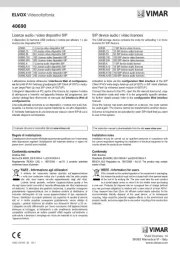
2 September 2025
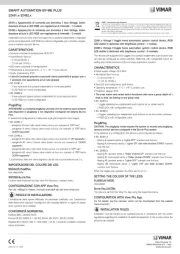
26 Augustus 2025
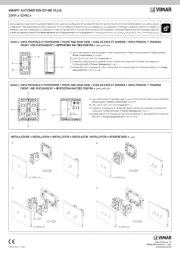
26 Augustus 2025
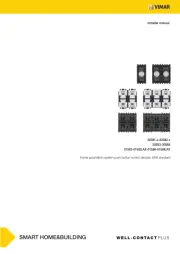
26 Augustus 2025
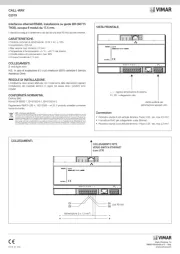
14 Augustus 2025
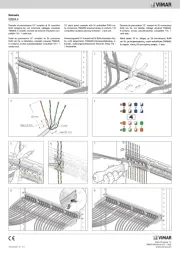
5 Juli 2025
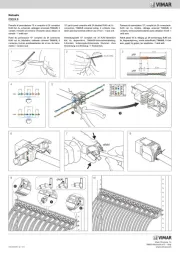
5 Juli 2025
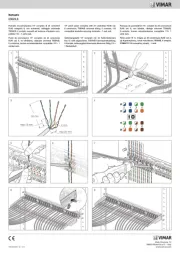
5 Juli 2025

5 Juli 2025
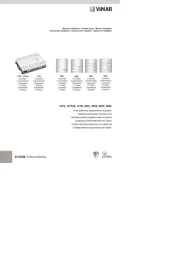
24 Mei 2025
Handleiding Niet gecategoriseerd
- Hom-io
- MPM
- XPower
- Caso
- Fibaro
- VigilLink
- Murideo
- TK Audio
- Melissa
- Phase One
- Leotec
- Weihrauch Sport
- Milestone Systems
- Brilliant
- HuddleCamHD
Nieuwste handleidingen voor Niet gecategoriseerd

14 September 2025

14 September 2025

13 September 2025

13 September 2025

13 September 2025

13 September 2025

13 September 2025

13 September 2025

13 September 2025

13 September 2025